In Bologna (occasionally) something moves and reminds us that emerging artistic production can be not only the first stage of an entrepreneurial path aimed at a desirable inclusion in the official art system, but also a laboratory of ideas and reflections, perhaps not yet perfectly “packaged” and disclosed as in the first case, but for this reason extremely alive in its raw relevance to the problems addressed and to the experimental approach to research (which should be) typical of every artist who has not yet been identified by a precise expressive code.
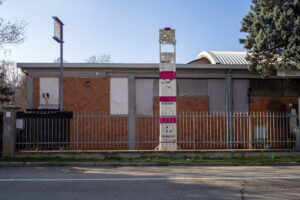
FARò 2023, collettivo TIST – This Is So Temporary, Faro, site-specific installation, courtesy TIST
The practice of TIST – This Is So Temporary moves in these territories, by their nature nomadic and liminal. Since 2021 the group has managed a virtuous artist-run space in Rastignano, directed by the curator Yulia Tikhomirova and the artist Michele Liparesi. The space which, located in an industrial area near Bologna, at first glance blends in with the other warehouses used for production and logistics, is proposed as a multimedia construction site of contemporary visual culture, hosting artistic residencies and projects conceived as “experiences” in which the public is invited to practice transversal forms of knowledge, at the crossroads between contemporary art and social life. It is precisely in this thematic context that the FARò. Political Aesthetic Practices project takes place, first edition of an annual event conceived as a survey of contemporary expressive processes that militate in the intersection between the fields of aesthetics and politics.
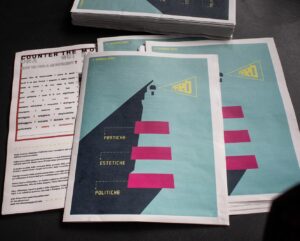
Pubblicazione FARò. Pratiche Estetiche Politiche. Numero 1, gennaio 2023, courtesy TIST
The opening, held just before Arte Fiera, brought together nine artists (Giorgina Della Porta, Michele Di Pirro, Massiel Leza, Michele Liparesi, MANINUDE, Matteo Montani, Enrico Vassallo, Uriel Schmid-Tellez and Laura Zizzi) who offered their different points of view on the future, returning it as a transformation capable of opposing the temporariness and precariousness that today seems, on several levels, to paralyze the present. To underline the connection between art, politics and society, the first issue of a thematic in-depth journal (with the format of a newspaper) was also presented, where the contributions by Enrico Chinellato + Or Haklai (QUIZEPO Collective) , Davide Ghelli Santuliana, Serendippo, Dario Sanna (Transhumanza collective), Mia da Schio Suppiej and Yulia Tikhomirova (TIST collective) underline the aggregative and transformative potential of artistic practices rooted in the territory understood as a field of investigation of new inclusive and sustainable models of coexistence . We did not attend the opening, but a few weeks later, we went to investigate what remains of it, discovering a collective work environment studded with artworks, perhaps even more fascinating than the official exhibition, which will be open to the public, by appointment, until February 25th.
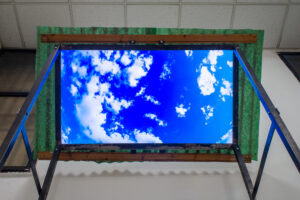
FARò 2023, Michele Di Pirro, Dispassionate feelings, site-specific installation, courtesy TIST
Outside the building we are welcomed by Faro, a site-specific installation by the TIST collective, a veritable watchtower with fog lights, created by assembling recycled household appliances and powered by solar panels, which from now on in the evening will signal the presence of the artist-run space, emphasizing its exceptional nature in the surrounding landscape. The building, on which the words “organized resistant art factory” stands out, metaphorically shows passers-by the way to the utopian place of an art that wants to be free from the dynamics of the market and established power. The structure is actively practicable by visitors, invited to climb up to observe the landscape in the light of the symbolic and aesthetic suggestions that arise from it.
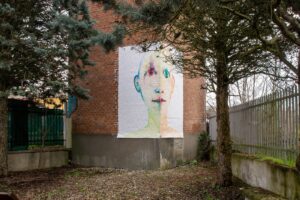
FARò 2023, Massiel Leza, site-specific installation, courtesy TIST
We continue in the room intended for temporary exhibitions with the Languishing group show curated by Maria Chiara Wang, which brings together three young artists called to interpret the condition of exhaustion evoked by the title with different media. Giorgina Della Porta manifests this painful stagnation with disturbing graphics populated by dreamlike beings ready to invade any surface, Michele Di Pirro with a sculpture in which the video footage of an intense blue sky crossed by clouds is rendered threatening by occasional interferences and from being placed on the back of a metal roof, while Massiel Leza identifies this sensation with the obsessive repetition of a grammatical mantra (sometimes perverted by the artificial voice that recites it) and with the watercolor dissolution of a large alien face divided into rectangular modules.
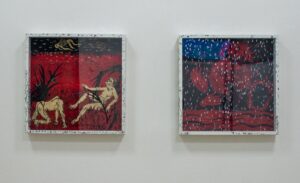
FARò 2023, Giorgina Della Porta, site-specific installation, courtesy TIST
From here we reach the design workshop of the designer MANINUDE (aka Alessandro Boselli) who, using open source software, recycled materials and other components expressly designed and built by him, created an environmental 3D printer operable via joystick, which on the opening day was experimentally activated to engrave a log of wood. The performative and functional potential of this sophisticated semi-handcrafted equipment, still under development, rethinks the convergence of human action, mechanical standardization and digital programming from an equal and collaborative perspective.
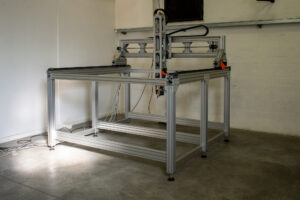
FARò 2023, MANINUDE, Meccatronica, site-specific installation, courtesy TIST
The visit continues with the study-installation by Matteo Montani, protagonist together with Enrico Vassallo of a performance in which the former’s paintings, made with a particular cementite compound, only by getting wet revealed the background image, otherwise destined to remain latent. On display we find some of his characteristic mental landscapes which, conceived as an iridescent expectation of an apparition generated by the adjustments of matter solicited by his intervention, anchor the vision to a changing spiritual dimension, which manifests itself through concealments and allusions.
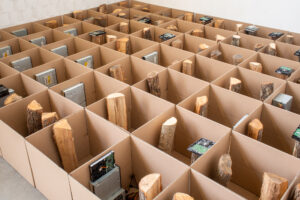
FARò 2023, Michele Liparesi, Instabilità geologica, site-specific installation, courtesy TIST
The installation Instabilità geologica by Michele Liparesi also reflects on precariousness, imagining a near future (already dystopian) in which the scarcity of natural resources makes their distribution contingent and difficult. The installation recreates the logistic hub of an imaginary (but not too unrealistic) “Agency for the sorting of primary goods for the human being” in which strict protocols try in vain to stem the emergency with the official language of bureaucracies. To counterbalance these sinister premonitions we find the Anti-monuments by the same artist (not included in the exhibition but perfectly relevant to the theme), utopian housing modules obtained from empty pedestals, which celebrate the individual right to a home with a view to re-appropriating and sharing public spaces.
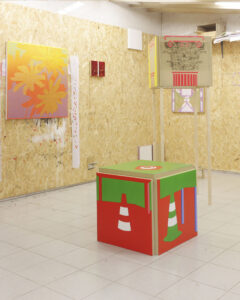
FARò 2023, Uriel Schmid-Tellez, Solid Works, site-specific installation, courtesy TIST
The visit ends in the studio of Uriel Schmid-Tellez, who in the environmental installation Solid works assembles formal and visual stereotypes taken from classical, modern and industrial architectures in a Pop key. The relationships between two-dimensional elements (coming from road signs) transformed into sculpture and between fragments of street furniture synthesized into images create a setting in which the instinctive sensory satisfaction one feels is immediately contradicted by the intuition that all the represented constructs are definitively emancipated from the human scale to which they were originally commensurate.
Info:
A.A.V.V. Farò: Pratiche Estetiche Politiche
TIST – This Is So Temporary
28.01-25.02.2023
via Vincenzo Bellini 1-3 Rastignano (Bologna)
www.instagram.com/tist.situations
Graduated in art history at DAMS in Bologna, city where she continued to live and work, she specialized in Siena with Enrico Crispolti. Curious and attentive to the becoming of the contemporary, she believes in the power of art to make life more interesting and she loves to explore its latest trends through dialogue with artists, curators and gallery owners. She considers writing a form of reasoning and analysis that reconstructs the connection between the artist’s creative path and the surrounding context.






NO COMMENT